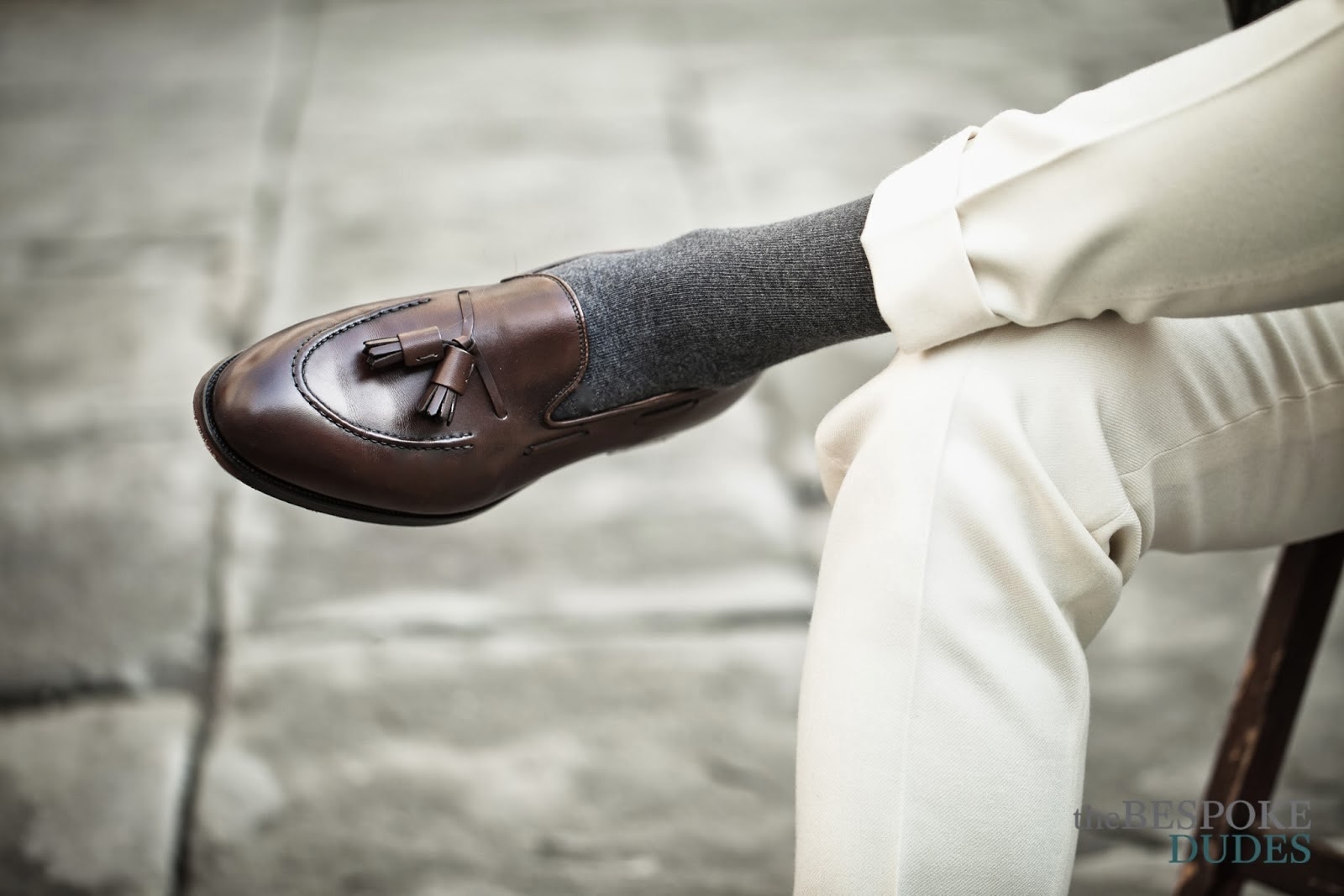"Always look at a man's shoes, they will tell you a lot about him"
"Di un uomo bisogna sempre guardare le scarpe, diranno molto di lui”.
The Article - L'articolo
An old saying goes: “Always look at a man’s shoes, they will tell you a lot about him”. The tenth and last article for Natural Gentleman is about the fascinating industry of the shoes. Just like for every other garment of a gentleman’s closet, also for the shoes a lot could be said and a web article may not be the most appropriate tool to write in depth about this matter, thus I will try to be concise.
Provided that buying an high quality pair of shoes is a lifetime investment, it is essential to debunk the myth according to which expensive shoes, being rigid, hurt. An excellent pair of shoes, except the case of an efficient marketing campaign, is not supposed to hurt and if this happens is just because of a wrong size or sole width. As for hand-made shoes, these are the basic steps. After the design phase, the leather and the lining are cut. The next step is the binding phase in which the previously-cut pieces are put together to make the upper. Then the upper is mounted onto the form and stitched (in Good Year type, Norvegian, Bologna, Tyrolean, or Tubular). Next is the sole-making phase that involves attaching sole and heel; finally the finishing phase is needed for the colour and the polishing. It takes twenty to thirty days to make a pair of shoes because there are technical intervals which must be respected: the finishing itself for example requires four or five days.
The current trend is all about double monks (named after the monks’ sandals for their buckles) and tassel loafers, with an increasing presence of slippers; on the contrary, the interest for driving loafers is waning. A tip: it is better to go for a “good-year welted” pair than for a blake one; only the first one can be changed if damaged and the shoes will return to mint conditions!
In the end, thanks to this nice (at least for me!) experience, not only did I have the chance to write down what I have learnt during the interviews of the past two years, but also it pushed me to reopen some dusty style books resting on my shelves, in order to check whether my statements were grounded . Thus, I would like to thank the guys of Natural Gentleman for this opportunity and you Dudes for your enthusiastic feedbacks. It is a mix of details that makes a man elegant and for sure “clothes don’t make the man, but they can help a man look great”! :D
____________________
L’argomento scelto per il decimo e ultimo articolo di questa rubrica è in ossequio ad un vecchio detto che dice “Di un uomo bisogna sempre guardare le scarpe, diranno molto di lui”. Come per molti altri accessori del guardaroba di un gentleman, anche qui le informazioni in merito sarebbero tante e non appropriate ad un semplice articolo sul web, locus per antonomasia della sintesi e dell’immediatezza, pertanto ci si limiterà a qualche rapido ma efficace pensiero.
Premesso che acquistare un paio di scarpe di qualità è un investimento che dura tutta la vita, è d’uopo sfatare il mito secondo cui le scarpe costose, siccome rigide, fanno male. Un ottimo paio di scarpe, salvo casi di marketing particormente efficace, non deve mai dar fastidio e se ciò accade, la colpa è da attribuire ad una taglia o larghezza della suola sbagliate. Per quanto riguarda le scarpe fatte a mano, ecco sinteticamente i passaggi necessari a crearla: dopo la progettazione, si procede al taglio di pelle e fodera. Lo step successivo è l’orlatura, cioè l’unione dei pezzi tagliati in precedenza, che vanno a formare la tomaia. Segue il montaggio della tomaia sulla forma, la cucitura (che può essere di tipo good year, norvegese, bologna, tirolese o tubolare), la suolatura per applicare suola e tacco e, infine, il finissaggio per il colore ed il lucido. I tempi di lavorazione vanno dai venti ai trenta giorni per un paio di scarpe, perché ci sono intervalli tecnici da rispettare; alcune fasi, come quella del finissaggio, in sé richiedono dai quattro ai cinque giorni lavorativi.
Il trend oggi vede un fiorire di scarpe doppia fibbia (in inglese double-monk straps perché ricordano i sandali dei monaci) e mocassini con nappine, accanto ad una presenza sempre maggiore delle slippers, a discapito dei mocassini con gommini, bolla sgonfiatasi dopo qualche anno di boom. Un consiglio: preferite sempre la suola Good Year a quella di tipo Blake, solo la prima, infatti, in caso di usura si potrà cambiare e le scarpe torneranno come nuove!
Al termine di questa piacevole (almeno per me) esperienza, in cui ho avuto modo di mettere nero su bianco quello che ho imparato in questi pochi anni di interviste e che mi ha anche spinto a riaprire quei libri di stile sugli scaffali per controllare la fondatezza delle mie asserzioni, ringrazio di cuore i ragazzi di Natural Gentleman per l’opportunità offertami e tutti voi lettori (Dudes) per i vostri feedback entusiasti. In definitiva, a coloro che giudicano futili tutti questi discorsi sullo stile, è bene rammentare che è l’insieme di tanti dettagli che rende l’uomo elegante e che, soprattutto, “clothes don’t make the man, but they can help a man look great”. :D
Bespoke hugs,Fabio Attanasio
If you like what we are doing here, please consider following TBD on Facebook - Tumblr - Instagram - Twitter
Bespoke Hugs,
Fabio
About the Shoes
21 March 2014







